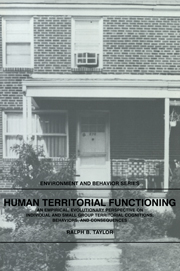 Human Territorial Functioning
Human Territorial Functioning Published online by Cambridge University Press: 05 February 2010
For that which is common to the greatest number has the least care bestowed upon it.
– AristotleTerritorial functioning, at the most basic level, involves a segmentation of space; locations are differentiated into those “belonging to” or used by one person or group, or another. As part of this allocation process boundaries are created or maintained. They are selectively permeable: Certain people at certain times, or for certain purposes, are allowed to enter one spatial segment from another, or to cross the boundary. The boundary may be clear-cut or fuzzy, agreed upon or disputed, acknowledged by others or ignored, and consistent or variable. Nonetheless, this process of spatial differentiation is fundamental to territorial functioning.
Focus of the chapter
This chapter considers issues of resource conservation from a territorial perspective.
How is resource conservation related to territorial functioning? Many natural resources are distributed spatially;that is, they are more plentiful in some places than in others. Oysters, growing on oyster beds, are an excellent case in point. Lobsters and crabs, although they migrate, are more plentiful in some locations than others. Wood is a resource clearly fixed in place. Energy resources such as oil and coal, although their refinement and distribution are often centralized, are more plentiful in some parts of a country than others. So, since territorial functioning involves the segmentation of space, and many resources are distributed unevenly in space, at certain levels differentiation into territories has implications for resource allocation, and, more importantly, resource conservation.
To save this book to your Kindle, first ensure [email protected] is added to your Approved Personal Document E-mail List under your Personal Document Settings on the Manage Your Content and Devices page of your Amazon account. Then enter the ‘name’ part of your Kindle email address below. Find out more about saving to your Kindle.
Note you can select to save to either the @free.kindle.com or @kindle.com variations. ‘@free.kindle.com’ emails are free but can only be saved to your device when it is connected to wi-fi. ‘@kindle.com’ emails can be delivered even when you are not connected to wi-fi, but note that service fees apply.
Find out more about the Kindle Personal Document Service.
To save content items to your account, please confirm that you agree to abide by our usage policies. If this is the first time you use this feature, you will be asked to authorise Cambridge Core to connect with your account. Find out more about saving content to Dropbox.
To save content items to your account, please confirm that you agree to abide by our usage policies. If this is the first time you use this feature, you will be asked to authorise Cambridge Core to connect with your account. Find out more about saving content to Google Drive.